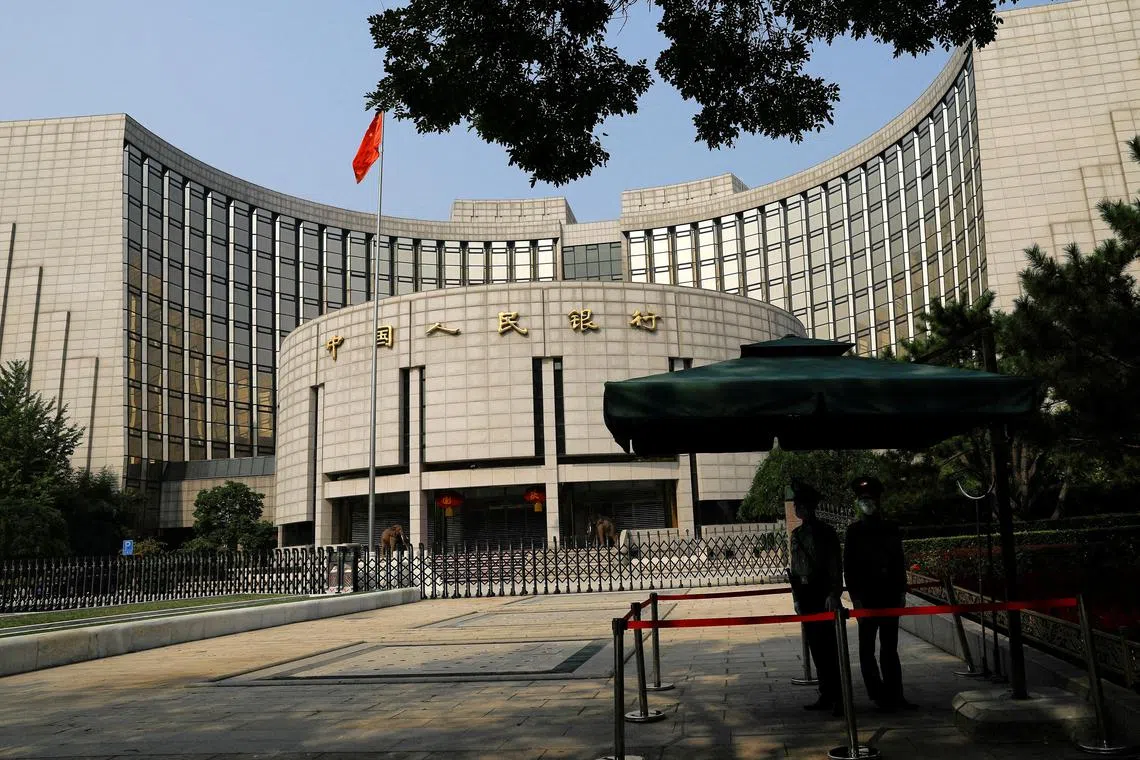Global banking woes put spotlight on China’s regional lenders
Sign up now: Get ST's newsletters delivered to your inbox

The People’s Bank of China estimates about 300 banks in China are risky, down from 420 in 2018.
PHOTO: REUTERS
Follow topic:
BEIJING - A global banking crisis has put China’s struggling regional lenders under new scrutiny following a sharp slowdown in the economy. But recent moves from Beijing should give investors some comfort.
As in the United States, China has a problem with its smaller regional banks who sit on more than 100 trillion yuan (S$19.3 trillion) in assets.
After years of efforts by the authorities to rein in risks in the sector, concerns are rising once again after the failure of Silicon Valley Bank
Making investors twitchy are memories of Beijing’s hawkish turn away from bailouts before the pandemic, when it allowed local lender Baoshang Bank to become the first Chinese bank to go bankrupt in nearly two decades.
However, analysts now say China will prioritise stability over concerns of moral hazard as it seeks to revive growth after years of bruising Covid-19 restrictions and are more likely to approve bailouts and mergers to prevent bank failures.
“Where the Chinese system is quite different from the EU or US banking system is the level of government support,” said Ms Grace Wu, senior director and head of China bank ratings at Fitch Ratings.
“There’s certainly example and evidence of more regulatory intervention by mainland authorities than what we may see in other parts of the world.”
President Xi Jinping also recently overhauled oversight of the financial system, placing it under tighter direct control of the Communist Party as he embarks on a norm-breaking third term.
Another clue Beijing is preparing for bailouts is the creation of a Financial Stability Fund in 2022, which raised 64.6 billion yuan in a first fundraising round.
Beijing has also encouraged provincial governments to issue 550 billion yuan of bonds used for recapitalising smaller banks since 2020.
That would be a return to the approach taken in the 2010s, when the authorities bailed-out several small lenders in north-east China.
The overhaul of the regulatory system suggests “quite a change from the central bank’s recent goals of enforcing financial discipline and avoiding moral hazard”, said Mr Wei He, an analyst at Gavekal Dragonomics.
A rebound in economic growth should help regional banks restore some of their profits.
And Beijing has spent recent years cleaning up local lenders, making them raise capital, and says it has made progress: The People’s Bank of China (PBOC) estimates about 300 banks in China are risky, down from 420 in 2018.
Still, Mr Sun Tianqi, director of the PBOC’s financial stability bureau, warned in a January commentary of potential “false” capital raising and cover-ups by banks to defuse risks, saying that institutions that are close to being rated high-risk will be closely monitored to prevent further deterioration.
The weaknesses of local banks are both on the asset and liability sides.
They have lent heavily to uncompetitive local companies and government pet-projects, leading to non-performing loans.
On the liability side, they are less able to attract stable deposit funding and rely on more flighty capital-market borrowing.
The pandemic exacerbated their situation.
Smaller lenders in China are more exposed to local government debt and small business loans, which have been most affected as the economy weakened from the collapse of the property market and zero-Covid policies.
They are also struggling financially from lower interest rates that have pressured net interest margins.
During the last economic down cycle in 2012 to 2016, small regional banks became steadily more risky after spending earlier years trying to roll over bad loans and survive.
A similar pattern is playing out now, as the health of smaller banks has deteriorated after the economic slump caused by Covid-19, said Ms Shujin Chen, an analyst at Jefferies Financial Group.
“Quite a lot of companies’ financial conditions have worsened and they have probably failed to pay loans, so smaller regional banks have become more vulnerable,” Ms Chen said.
Those vulnerabilities are rising to the surface as several banks just in March have chosen not to exercise redemption options on Tier-2 capital bonds, including Yantai Rural Commercial Bank and Anhui Taihe Rural Commercial Bank.
Prior to that, Bank of Jiujiang, retracted a decision not to redeem such bonds after a market sell-off.
Frequent non-redemptions overlaid with market concerns about asset quality are raising financing costs for local banks.
From 2017 to 2022, about 44 small banks, mostly rural lenders, chose not to redeem Tier-2 capital bonds, according to a research note by Sinolink Securities.
The bonds are a key channel to maintain capital-sufficiency ratios, with such debt usually having long tenors of 10 to 15 years and dates that allow for early redemption.
Investors expect issuers to redeem the notes on the first call date.
MacroPolo estimates that the average asset to equity ratio at regional lenders is higher than 30 – nearly as leveraged as US investment banks were before the global financial crisis, according to an analysis by the US think-tank.
That compares with about 10 to 12 at China’s large state-owned lenders.
“If the economy doesn’t experience a meaningful mini boom, more local banks will be exposed and be under a lot of pressure,” said Professor Chen Zhiwu, a professor of finance at the University of Hong Kong Business School. BLOOMBERG

